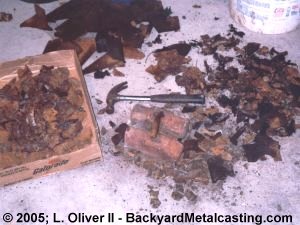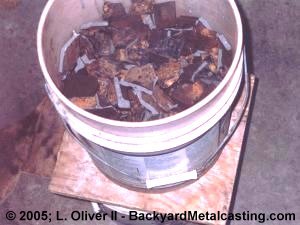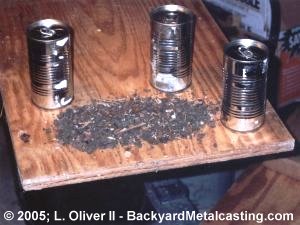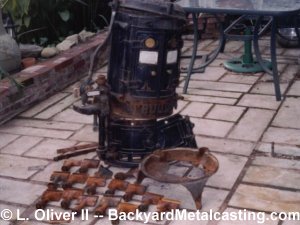These corroded drain pipes are a plentiful source of scrap iron. Many old homes have drainage systems composed of these pipes and after a few decades they seem to just crack down the center for some reason. I've seen several cases of this and plenty of discarded iron pipe. As I mentioned before, cast iron is very brittle (because of its high carbon content) so a sledge hammer crushes this brittle iron material into cupola or crucible fitting pieces with ease. While the surface of the iron is rusty the inside is a very nice grey color.
Here is a long piece of drain pipe dug out from someone house when the drainage system was replaced.
Believe it or not this barbecue grill is entirely composed of cast iron. The "cage" area is one casting and the bottom "tub" is a separate casting. This is a heavy outdated grill and it's time for it to be turned into something better. Once again, the sledge hammer slapped the iron around until it yielded.

Any scrap iron has to be broken into pieces small enough to melt in the time it takes the fuel charge to burn away (in a cupola or cupolette). Fortunately cast iron is very brittle and breaks relatively easily. Here I've been setting pieces of iron across two sledge hammer heads and breaking it with a hammer. Breaking scrap iron with a hammer put's alot of kinetic energy into the metal. It can send pieces flying off with incredible force! ALWAYS wear safety glasses and gloves when breaking scrap iron! If available; body armor and a military flack jacket are also recommended.

Here is a 5 gallon plastic bucket of scrap cast iron. This is actually so convenient for storage that I don't think it really needs to be cast into ingot form. And that's a good thing too, because it takes a lot of fuel to melt iron and I don't want to use it to make iron ingots. Take note of the internal grey color of the iron. As I mentioned before, the surface is rusty but below the surface it's clean grey iron.

When breaking apart very rusted iron there are often a lot of iron "crumbs" that fly around. Not wanting to let them go to waste I collect them and pour them into steel cans. I'll then drop the cans into the a crucible and melt the iron with my used oil burning furnace.

Here is one of my sources for scrap iron. This is some of the remains of the cast iron shell of an antique RUUD water heater from about 1908. The base was all burned out and oxidized so I decided to scrap it. My original plan was to restore it just so it'll look nice but it's worth more as a scrap source. I took the internal copper coil to a scrap recycler (it was at least 30 pounds of copper) and got about 50 bucks for it! I got this heater from a neighbor who wanted to clean out his basement. I toted the thing back to Lab HQ on a hand truck. It had to be over 200 pounds of cast iron. Busting this thing up with a sledge hammer was quite enjoyable. I also recovered about 20 pounds of bronze from the valving and such mechanisms.
For you gas burner fans this picture is of some of the water heater burners and the method in which they worked in the RUUD water heater. Gas entered the ring and the bronze nozzle blew it in the burner's venturi. As you can see the venturi "bell" is cast in place. This ring had a bronze nozzle (with a very small jet hole) and burner in each hole.
Here is a trash can almost filled with scrap iron. This iron is actually the broken remains of and Antique RUUD water heater shell shown on another iron melting page. Yep, this is a short page, I'd have some photos of the iron melting but... well, the cupola was crap!
Before I had a refractory crucible I had a strong urge to test my waste oil burner with iron. Here is a chunk of iron from a drainage pipe flange that I took out of the furnace after it just started melting. I had it in a tuna fish can which burned away but you can see the remains of it in the photo. The iron was so close to completely liquifying that I was able to easily push this 3/8" steel rod through it. Before I took this out the furnace I did see at least one drop of iron trickle onto the furnace floor. Next is scrap iron Part 3.